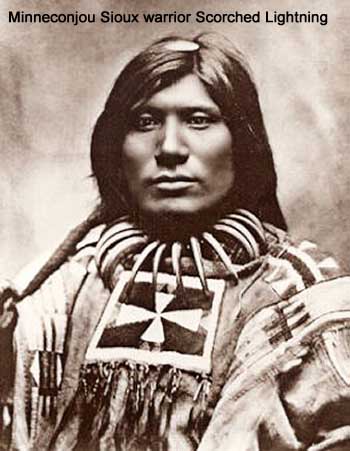|
||||||||||||
Bruce Brown's 100 Voices... Turtle Rib's Story of the Battle
TURTLE RIB'S ACCOUNT
The fighting (Reno) started against the camp of the Uncapapas. He (Turtle Rib) was asleep when the soldiers were first reported in the valley but got in before the fighting stopped and killed one of the Rees. He saw other Rees getting away with a drove of Sioux ponies. [Note: here is Strikes Two's account of stealing the Sioux and Cheyenne ponies.] The fighting against Reno did not last long. He could not say how many minutes, but only a few. He did not see the fighting at Ford B [Medicine Tail Coulee], but when he passed back through the village to go against the soldiers on the high ground across the river (Custer) the women were stampeded and the children were crying. They said soldiers had come over the hill from the east and had been driven back. When he got up with the soldiers, there was a running fight with some of the soldiers on foot. Those who kept their horses seemed to be stampeded. Some were going toward the monument, and some were trying to ride back the way they came. Those on foot seemed to be the coolest and fought the hardest. No stand was made except at the end of the long ridge (where Custer fell), and here the bay and gray horses were all mixed together. There was a big dust, and the Indians were running all around the locality much excited and shooting into the soldiers. He saw one soldier ride across a hollow and try to get away. He was the third Indian to give chase. The soldier rode like the wind and appeared to be getting away from them, when he killed himself. He could not recall the direction in which this soldier went. When he returned, the fight was nearly over. The Indians were up close, and the soldiers were shooting with pistols. He saw some of the soldiers shoot each other. [Note: see Who Killed Custer -- The Eye-witness Answer for more info about American suicides at the Little Bighorn.] The Indians were all around. Some of them shot arrows and in the smoke and big dust hit their own men. His own nephew was killed here by a soldier's bullet. The Indians had many killed and more wounded. It took a good many to bring water up from river to the wounded Indians. He never heard the number of Indians killed. They captured many horses and got much ammunition from them. They took no soldiers off the battlefield alive. He supposed them all killed where they lay. The Indians were so busy caring for their own wounded and going off to fight Reno that they did not stop to scalp or mutilate soldiers. What the squaws did after this he did not know, as scalping of dead or mutilation would be nothing uncommon with Indians. The Indians did not recognize Custer fighting or afterward among the dead. Walter Mason Camp's Notes: 1. Walter Camp field notes, folder 105, BYU Library. Custer in '76: Walter Camp's Notes on the Custer Fight, edited by Kenneth Hammer, Brigham Young University Press 1976 p 201 - 202
Here's the account of another Minneconjou Soux, war chief Red Horse.
|
||||||||||||




 NOW 60 YEARS old, a member of Minneconjou Sioux. He fought under Lame Deer. He was not in the battle with Crook [the
NOW 60 YEARS old, a member of Minneconjou Sioux. He fought under Lame Deer. He was not in the battle with Crook [the 







